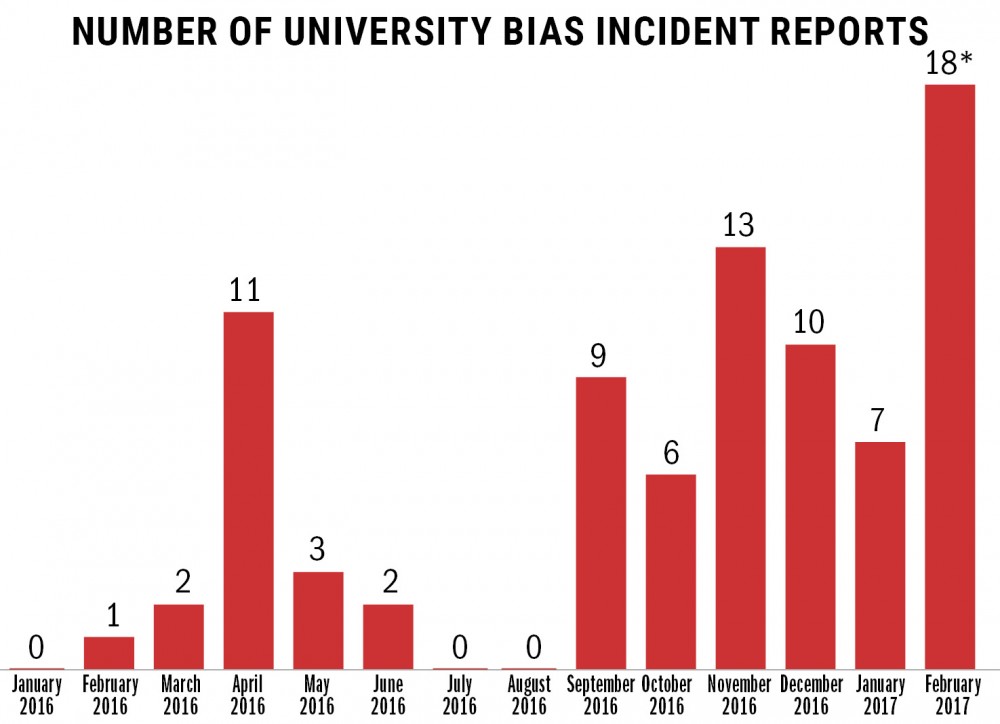The University of Minnesota’s Bias Response and Referral Network received at least 18 incident reports in February, the largest number reported in any month since its start in January 2016.
Though the Southern Poverty Law Center — an advocacy organization specializing in civil rights — has announced a decrease in bias reports since a spike following the presidential election; other Big Ten colleges have seen similar surges.
Officials from the University and other schools attribute the increase in bias reports to political climate resulting from the presidential election as well as resource awareness.
Records from January 2016 through Feb. 22, 2017, show a total of 82 bias reports. The incidents range from the highly-visible, like a January report of a swastika stomped on to the practice football field, to more personal accounts, like a report from a student worried that a poor grade was given due to bias.
One reason for the uptick in reports is increased awareness of the team, said BRRN member and Office of Equal Opportunity and Affirmative Action Director, Tina Marisam. The BRRN website just launched last fall, and this spring, the University-wide “We all belong here” effort helped spread information about the network, she said.
She also attributes the uptick to the political climate.
“My sense is that our University is not alone in this. Other universities are also … experiencing more conversation about these social identities and also more bias incidents,” she said.
For example, 106 reports have been made this academic year at the University of Illinois Urbana-Champaign, which is a significant increase from the last several years, said Associate Dean of Students Justin Brown.
“We … put it on the shoulders of the election cycle and the actual inauguration and things happening pretty much directly as a result of a very unpleasant political climate,” he said.
There has been a slight increase in reports at the Indiana UniversityBloomington, said Associate Dean of Students Carol McCord. However, McCord doesn’t think numbers accurately reflect campus climate because incidents often go unreported.
“I don’t believe for a second these are all the problems people are having,” she said.
Multicultural center and counseling staff have told McCord they’ve met with worried students more than they did before the election, she said.
But nationally, reports of bias incidents and hate crimes have declined since a post-election surge in November, said Alex Amend, Southern Poverty Law Center digital media director. The SPLC, a left-leaning organization, tracks hate crimes as part of its advocacy efforts.

In response to the rise in hate crimes last fall, the SPLC implemented an online reporting system to assess the situation nationwide, Amend said, adding that the response was overwhelming. They received over 850 reports in the first ten days following President Donald Trump’s election, he said.
The incidents ranged from vandalism to heated exchanges escalating into racial slurs, he said. Since November, reports have slowed, possibly because the initial surprise of Trump’s election has worn off, he said.
“Some people might feel that they’ve been granted license to kind of be a little more open in their ignorance and their bigotry than they might’ve before,” he said.
At the same time, alt-right and white nationalist flyers have popped up at abnormally high levels since the election season, Amend said.
Amend said organized alt-right and white supremacist groups see Trump’s election as confirmation of their beliefs and a new potential to recruit members. Putting up flyers is protected by the First Amendment, Amend said, but it has been causing turmoil at colleges and universities around the country.
The University’s BRRN has received four reports of white nationalist or alt-right posters on campus since it launched last year, all of which took place in February.
Records show that in three instances, the BRRN did not recommend removing flyers because they did not violate University policy. However, a flyer with “extremely anti-Semitic, white nationalist language” that claimed to be from the white supremacist website Daily Stormer was removed by the University of Minnesota Police Department, records show.
Editor’s Note: Alex Amend is a former Minnesota Daily reporter.

















